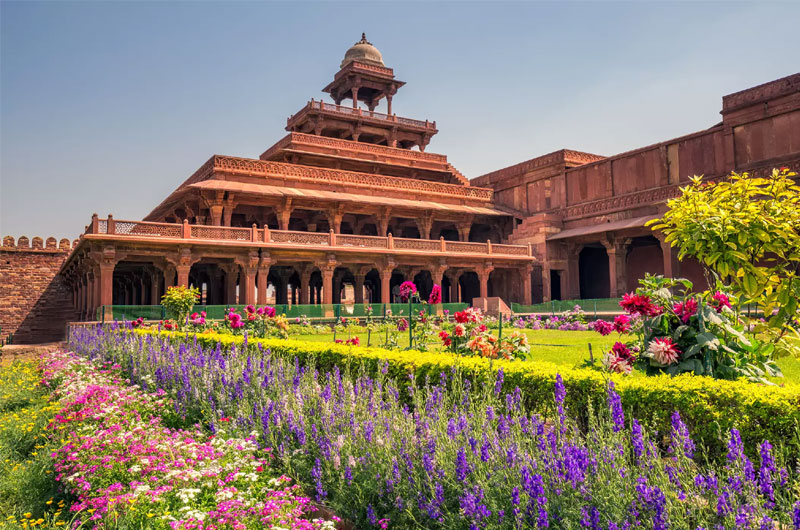
Fatehpur Sikri: Architectural Splendor Frozen in Time – A World Heritage Site
Fatehpur Sikri, located near Agra in Uttar Pradesh, India, is a UNESCO World Heritage Site that encapsulates the grandeur and architectural brilliance of the Mughal Empire during the reign of Emperor Akbar. Built in the late 16th century, Fatehpur Sikri served as the capital of the Mughal Empire for a brief period, showcasing a unique synthesis of Islamic, Persian, and Indian architectural styles. Today, it stands as a well-preserved ghost city, offering a glimpse into Mughal history, culture, and administrative prowess.
Historical Background
- Foundation and Significance
- Founded by Emperor Akbar in 1569 as the new capital of the Mughal Empire.
- Served as a political and cultural center for approximately 15 years before being abandoned.
- Cultural Fusion
- Reflects Akbar’s vision of religious tolerance and architectural innovation.
- Features buildings influenced by Hindu, Jain, and Islamic architectural traditions.
Architectural Marvel
- Design and Structure
- Designed on a grand scale with red sandstone buildings and marble palaces.
- Layout includes royal palaces, courts, mosques, and public buildings.
- Notable structures include Buland Darwaza, Jama Masjid, Diwan-i-Khas, and Panch Mahal.
- Notable Structures
- Buland Darwaza: A massive gateway marking the entrance to Fatehpur Sikri, known for its grandeur and inscriptions.
- Jama Masjid: A vast mosque with elegant domes, minarets, and a central courtyard.
- Diwan-i-Khas: Hall of Private Audience with intricate carvings and a central pillar.
- Panch Mahal: A five-story palace with open pavilions, offering panoramic views of the city.
Specialty of Fatehpur Sikri
- Architectural Diversity
- Represents a fusion of Central Asian and Indian architectural styles.
- Showcases Akbar’s architectural experiments and innovations.
- Historical Significance
- Symbolizes Akbar’s efforts to promote religious harmony and cultural integration.
- Provides insights into Mughal court life, governance, and artistic patronage.
Tourism Aspects
- Visitor Experience
- Guided tours available to explore the various monuments and learn about their historical and architectural significance.
- Sound and light shows in the evening offering a dramatic retelling of Fatehpur Sikri’s history.
- Well-preserved pathways and gardens providing a tranquil atmosphere for visitors.
- Nearby Attractions
- Taj Mahal: A UNESCO World Heritage Site located in Agra, renowned for its exquisite Mughal architecture.
- Agra Fort: A historic fort and palace complex housing several notable buildings and gardens.
- Tomb of Salim Chishti: A white marble mausoleum within Fatehpur Sikri, revered for its spiritual significance.
- Events and Festivals
- Urs of Salim Chishti: Annual festival celebrating the Sufi saint, attracting pilgrims and devotees.
- Taj Mahotsav: A cultural festival held annually in Agra, showcasing music, dance, and handicrafts.
Impact on Locality
- Economic Significance
- Boosts tourism and local businesses in Agra and surrounding areas.
- Supports hospitality industry, guides, artisans, and souvenir vendors.
- Cultural Influence
- Enhances regional pride and historical awareness.
- Promotes preservation of traditional crafts and cultural heritage.
Preservation and Challenges
- Conservation Efforts
- Managed by the Archaeological Survey of India (ASI).
- Ongoing restoration and maintenance to preserve the structural integrity and historical authenticity of the monuments.
- Challenges
- Preservation against natural weathering, pollution, and visitor impact.
- Balancing tourism with conservation needs to ensure sustainable development.
Conclusion
Fatehpur Sikri stands as a remarkable testament to the architectural and cultural achievements of the Mughal Empire under Emperor Akbar. As a UNESCO World Heritage Site, it attracts visitors from around the globe, offering a glimpse into India’s rich history, art, and architecture. The ongoing efforts to preserve and showcase Fatehpur Sikri ensure that it continues to inspire awe and admiration for its grandeur and historical significance for generations to come.
